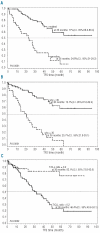White blood cell count at diagnosis and immunoglobulin variable region gene mutations are independent predictors of treatment-free survival in young patients with stage A chronic lymphocytic leukemia
- PMID: 21193417
- PMCID: PMC3069243
- DOI: 10.3324/haematol.2010.028779
White blood cell count at diagnosis and immunoglobulin variable region gene mutations are independent predictors of treatment-free survival in young patients with stage A chronic lymphocytic leukemia
Abstract
A comprehensive panel of clinical-biological parameters was prospectively evaluated at presentation in 112 patients with chronic lymphocytic leukemia (<65 years), to predict the risk of progression in early stage disease. Eighty-one percent were in Binet stage A, 19% in stages B/C. Treatment-free survival was evaluated as the time from diagnosis to first treatment, death or last follow up. In univariate analysis, advanced stage, hemoglobin, platelets, white blood cell, leukemic lymphocyte count, raised beta 2-microglobulin and LDH, unmutated immunoglobulin variable region genes, CD38, del(17p), del(11q) and +12, were significantly associated with a short treatment-free survival; the T/leukemic lymphocyte ratio was associated with a better outcome. Multivariate analysis of treatment-free survival in stage A patients selected a high white blood cell count and unmutated immunoglobulin variable region genes as unfavorable prognostic factors and a high T/leukemic lymphocyte ratio as a favorable one. At diagnosis, these parameters independently predict the risk of progression in stage A chronic lymphocytic leukemia patients.
Figures

Similar articles
-
Clinical and molecular predictors of disease severity and survival in chronic lymphocytic leukemia.Am J Hematol. 2007 Dec;82(12):1063-70. doi: 10.1002/ajh.20987. Am J Hematol. 2007. PMID: 17654680
-
IGHV gene mutational status and 17p deletion are independent molecular predictors in a comprehensive clinical-biological prognostic model for overall survival prediction in chronic lymphocytic leukemia.J Transl Med. 2012 Jan 30;10:18. doi: 10.1186/1479-5876-10-18. J Transl Med. 2012. PMID: 22289136 Free PMC article.
-
Comprehensive assessment of prognostic factors predicting outcome in Chinese patients with chronic lymphocytic leukemia treated with fludarabine and cyclophosphamide.Med Oncol. 2012 Sep;29(3):2102-10. doi: 10.1007/s12032-011-0054-2. Epub 2011 Sep 1. Med Oncol. 2012. PMID: 21881978
-
Adverse prognostic features in chronic lymphocytic leukemia.Oncology (Williston Park). 2011 Jul;25(8):692-6, 699. Oncology (Williston Park). 2011. PMID: 21874830 Review.
-
Genetics of chronic lymphocytic leukemia: genomic aberrations and V(H) gene mutation status in pathogenesis and clinical course.Leukemia. 2002 Jun;16(6):993-1007. doi: 10.1038/sj.leu.2402537. Leukemia. 2002. PMID: 12040431 Review.
Cited by
-
Mutations of NOTCH1 are an independent predictor of survival in chronic lymphocytic leukemia.Blood. 2012 Jan 12;119(2):521-9. doi: 10.1182/blood-2011-09-379966. Epub 2011 Nov 10. Blood. 2012. PMID: 22077063 Free PMC article. Clinical Trial.
-
NOTCH1 mutations in +12 chronic lymphocytic leukemia (CLL) confer an unfavorable prognosis, induce a distinctive transcriptional profiling and refine the intermediate prognosis of +12 CLL.Haematologica. 2012 Mar;97(3):437-41. doi: 10.3324/haematol.2011.060129. Epub 2011 Dec 29. Haematologica. 2012. PMID: 22207691 Free PMC article.
-
Genetic landscape of ultra-stable chronic lymphocytic leukemia patients.Ann Oncol. 2018 Apr 1;29(4):966-972. doi: 10.1093/annonc/mdy021. Ann Oncol. 2018. PMID: 29365086 Free PMC article.
-
Clinical implications of the molecular genetics of chronic lymphocytic leukemia.Haematologica. 2013 May;98(5):675-85. doi: 10.3324/haematol.2012.069369. Haematologica. 2013. PMID: 23633543 Free PMC article. Review.
-
Prognostic models for newly-diagnosed chronic lymphocytic leukaemia in adults: a systematic review and meta-analysis.Cochrane Database Syst Rev. 2020 Jul 31;7(7):CD012022. doi: 10.1002/14651858.CD012022.pub2. Cochrane Database Syst Rev. 2020. PMID: 32735048 Free PMC article.
References
-
- Gentile M, Mauro FR, Guarini A, Foà R. New developments in the diagnosis, prognosis and treatment of chronic lymphocytic leukemia. Curr Opin Oncol. 2005;17(6):597–604. - PubMed
-
- Rai KR, Sawitsky A, Cronkite EP, Chanana AD, Levy RN, Pasternack BS. Clinical staging of chronic lymphocytic leukemia. Blood. 1975;46(2):219–34. - PubMed
-
- Binet JL, Auquier A, Dighiero G, Chastang C, Piguet H, Goasguen J, et al. A new prognostic classification of chronic lymphocytic leukemia derived from a multivariate survival analysis. Cancer. 1981;48(1):198–206. - PubMed
-
- Montserrat E. New prognostic markers in CLL. Hematology Am Soc Hematol Educ Program. 2006:279–84. - PubMed
-
- Kay NE, O’Brien SM, Pettitt AR, Stilgenbauer S. The role of prognostic factors in assessing ‘high-risk’ subgroups of patients with chronic lymphocytic leukemia. Leukemia. 2007;21(9):1885–91. - PubMed
Publication types
MeSH terms
Substances
LinkOut - more resources
Full Text Sources
Research Materials

